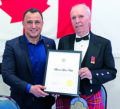Archive
Aurora Soccer Club celebrates 60 years of hard work and success
December 17, 2014 · 0 Comments
By Jake Courtepatte
In 1954, a group of Dutch immigrants came together to lay the foundation of the Aurora Soccer Club.
Dick Brom, aided by Martin Nabuurs, became the first president of the organization, with brothers Martin and Ted Dol also becoming heavily involved in the club’s early days.
These are just some of the names that had a hand in the formation of the Aurora Soccer Club (ASC), which is celebrating its 60th anniversary this year.
It is an organization built literally from the ground up.
In those early days, home games were played on Saturday afternoons at Town Park, and at St. Andrew’s College when Town Park was unavailable.
For these die-hard soccer fans, the season didn’t end with the coming of winter. Instead, training took place in the basement of Wells Street Public School during the winter months, on a concrete floor.
Joining the Newmarket and District Soccer League (NDSL), the club played against the likes of teams representing Barrie, Midland, Collingwood, Stouffville, Richmond Hill, and Newmarket.
After a few years, the team moved to Fleury Park, down the street from the old Aurora Memorial Arena.
In 1967, the same year the Aurora Community Centre replaced the burned-down rink, the ASC started the Aurora Minor Soccer Association, providing opportunities for over 400 boys to play soccer.
They would hold this position for seven years, until the minor organization split off to become what is known today as the Aurora Youth Soccer Club (AYSC).
The 1970s saw outstanding success for the ASC’s two primary men’s teams, the United and the Rangers, earning several league titles throughout the decade.
As the club grew in population and skill, their basic amenities had to be improved and refurbished.
With the club at the top of its game, Geering recalls the year that the club was finally required to provide a fenced-in park.
“I remember Ben (Steenhorst), myself, and a couple of other guys would go to the town to pick up some picket fences so we could say we had a fenced park. So, we used to put the fence up, and take it down after every game.”
The trials and tribulations that went into building the organization from the ground-up are not forgotten by its early members.
In 1984, the club was approached by then-Councillor John West, as Chair of Aurora’s Leisure Services Board, with an offer of 4.5 acres of land on Industrial Parkway South.
Although the property had no hydro, water or sewage, after a few meetings the club decided to go for it.
They signed a lease for a minimal fee, opting with the name Alliance Park, known today as Highland Park.
With fundraising now a priority, the first major issue came in the slope of the land, much too uneven for soccer.
The members were able to convince a construction company to grade the land for $20,000, and the organization had its playing ground.
Paul Dunbar, vice-president of the ASC, recalls one of Steenhorst’s stories surrounding the new park.
“You had to be within ‘X’ amount of distance from a fire hydrant. So they went and borrowed a hydrant, dug a hole and stuck it in the ground…things were different in those days.”
To this day, Geering approximates $900,000 being put into the club and park over its history.
“We just want to let the new folk in town what it’s all about,” said Geering. “It’s been a lot of effort over the years.”
The club’s ultimate claim-to-fame was the 2001 Ontario Cup win by the Hearts, eventually taking the third-place bronze medal at the Challenge Cup on the national stage.
Although eleven teams are currently playing out of the organization, the club maintains its non-profit status, even raising extra funds for charities in the area.
Dunbar has been with the organization for only eight years, but he appreciates the hard work and dedication it took to build the Aurora Soccer Club into what it is today.
“I think it’s a huge part of the heritage of Aurora, having something that’s been there and thrived so well for so long. It says something about the community. I hope it’s there for many, many years to come.”
With files from Dave Geering.











